This post may contain affiliate links. Please read my disclosure policy.
On its own, the word greenwashing seems perfectly harmless, right? It actually seems kind of positive! Green probably makes you think of all things natural and organic and safe — all things that I love, as you know. And washing is obviously a good thing! But here’s a twist: putting the two words together actually gives you something pretty sneaky. In this case, the whole is definitely not the sum of its parts. And we need to talk about it.
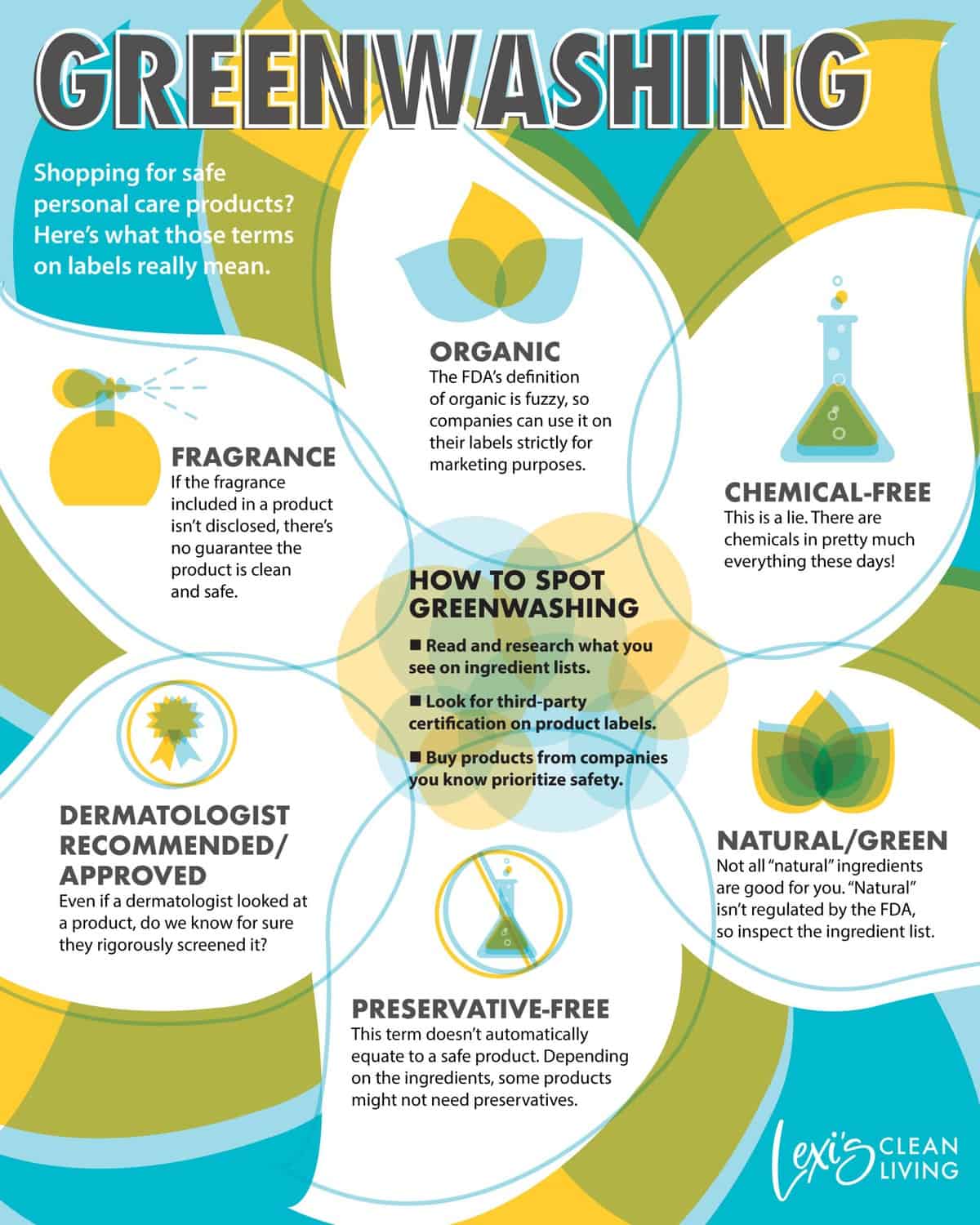
Everything You Need to Know About Greenwashing
So let’s talk about greenwashing.
Basic definitions are always helpful, so we’ll start there. Greenwashing has come into our common vocabulary pretty recently, but it’s already made it to the Cambridge Dictionary! According to those highly-respected word pros, to greenwash means “to make people believe that your company is doing more to protect the environment than it really is.”
Basically, any company that greenwashes its products is using its labeling and marketing to mislead consumers, doing everything they can to convince potential buyers that they’re buying something that’s better for the environment — and for them! — than it really is. Greenwashing is becoming a bigger issue as more people make the commitment to switch to natural products.
Don’t get me wrong. I’m thrilled to hear that so many people are learning about the issues associated with the health, cosmetic, and personal care industries. Remember: the U.S. is way behind other countries in terms of the demands the government puts on companies to take responsibility for the ingredients in their products and how they might affect consumers. The last time a federal agency updated its restrictions on these industries was all the way back in 1938. There are only 30 ingredients currently banned from personal care products in America. Compare that to 600 restricted ingredients in Canada and a whopping 1400 restricted ingredients in the European Union.
So, yes, it’s amazing that there’s a movement toward natural, safer products — but when companies aren’t backing those products up with ingredients that are actually more natural and safe than the alternatives, it’s a problem. As of January 2020, 70% of American consumers say they prefer natural and organic cosmetics. Again — great news! But as long as greenwashing is an option for big business, the natural, organic products you’re purchasing might not be all they seem.
This is why we all have to be sure we’re educated on greenwashing!
When you take the time to learn about greenwashing and how it actually presents itself in the wild (AKA out in stores and online), you’ll have the hard facts you need to see through the false advertising and make more informed choices about the cosmetics and personal products you’re bringing into your home. So let’s all get on the same page, shall we?
First, let’s do a little refresher about why it’s important to seek out products that are legitimately clean and safe. This will help you better understand what’s at stake when big brands are less than truthful with their greenwashing practices.
Here are a few of the benefits to clean products, according to Harvard Health…
- They’re less likely to irritate your skin. Many mainstream personal care products are made with irritants and allergens that will cause reactions for your skin, including formaldehydes, petroleum distillates, and fragrance. Allergic reactions aside, do you really want formaldehyde and petroleum in the products you’re putting on your skin? That’s definitely a pass for me.
- They aren’t made with endocrine disruptors. Common cosmetic ingredients like parabens, phthalates, and petroleum distillates are thought to cause problems in the endocrine system. Endocrine disruptors can cause hormone changes.
- They aren’t made with carcinogens. Let’s circle back to formaldehyde. In addition to being an irritant, formaldehyde has been linked with cancer. And that’s not the only carcinogenic ingredient you’ll find in common personal care products! Coal tar products and petroleum distillates — both of which you’ll find in many items you’ll find at the drugstore — are also carcinogenic.
Clean products also tend to be better for the environment, because they are made with natural ingredients. Non-organic products are often produced with ingredients and manufacturing processes that cause pollution and other environmental damage.
Clearly, there are a lot of pros to using truly green, natural products, which is why so many companies are trying to jump on the trend! The problem creeps in when brands use greenwashing tactics to trick consumers into buying items that aren’t actually clean. Believe it or not, there are sneaky marketing strategies they can use to make you trust that you’re buying something safe when you’re actually buying a product made with skin irritants, endocrine disruptors, carcinogens, and more.
There’s a lot at stake for everyone involved — but especially for you and your family.
I want to help you get ahead of those greenwashing tactics so you can keep your loved ones safe! There are a few key things you can look out for on product labels that might tip you off to the fact that greenwashing is afoot. These terms should jump out at you next time you’re shopping for safe personal care products:
- Fragrance: I have a lot to say about fragrance and you can read all of it here. It’s worth noting in this post, though, that if fragrance is on an ingredient list, it’s likely a sign of greenwashing. The word “fragrance” is protected by trade secrets, which means it can contain any number of chemicals that you’ll never actually know anything about. If the fragrance included in a product isn’t fully disclosed, we can’t guarantee that the product is actually clean and safe.
- Chemical-Free: This is a lie. I hate to break it to you, but there are chemicals in pretty much everything these days! This is a false promise — and one made frequently by greenwashing companies.
- Organic: Everyone’s looking out for “organic” these days, and major brands are playing into that. The FDA’s definition of organic is very fuzzy, which means companies can slap it on their labels strictly for marketing purposes. Because the word “organic” is so non-specific, your better bet is to look at the list of ingredients on the product label. If you can’t pronounce what you’re looking at, you don’t have an organic product in your hands.
- Natural/Green: There are plenty of technically “natural” ingredients that aren’t actually good for you. There are even some synthetic ingredients that won’t hurt you! Like “organic,” “natural” isn’t regulated by the FDA. Take it to the ingredient list.
- Dermatologist Recommended/Dermatologist Approved: This doesn’t actually mean anything. Even if a dermatologist looked at a product, do we know for sure that they rigorously screened it?
- Preservative-Free: Seeing this term on a label doesn’t automatically equate to a safe product. Depending on the ingredients, some products might not need preservatives. In other cases, preservatives are there for good reason, to prevent the growth of mold and bacteria.
Here are a few other things you can do to prevent becoming a victim of greenwashing…
- Read and research what you see on ingredient lists. I’ve said it before and I’ll say it again! Don’t be fooled by the marketing language you see printed on splashy font on the front of a product. Pay more attention to the fine print, which lists everything the product is made with. If a product doesn’t have information about its ingredients on the label — labeling practices are fuzzy in the U.S. — that should be a red flag. I like the Environmental Working Group as a resource to dig into random products I’m curious about.
- Look for third-party certification on product labels. If a product is certified by the Natural Products Association, NaTrue, BDIH, or EcoCert, that’s a good sign that you’re looking at something that’s actually safe, rather than greenwashed.
- Buy products from companies you know prioritize safety. The more transparent a company is with their practices, the more comfortable you can feel investing in them. Primally Pure and Branch Basics are great examples of brands I trust! I’ve always felt comfortable using their products in my home, and I love sharing them with all of you. You never have to worry about greenwashing when you shop with them! As consumers, we vote with our dollars every single time we make a purchase. So by choosing truly safer products, we are speaking volumes about what we want and what we deserve, and we deserve better!
- Follow informed and reliable influencers/brands/sources. My friend Carly is one of my favorites to follow. She knows her stuff! On greenwashing she says, “don’t fall for it! My best piece of advice to avoid greenwashing is to literally pretend the front label doesn’t exist! Turn it over, look at the ingredients, use EWG to see if any of them are allergens, carcinogens, endocrine/hormone disruptors, developmental/reproductive toxins, neurotoxins, or skin irritants, and make an educated and informed choice.”
Here are just a few of my favorite non-greenwashed brands and products…
- Branch Basics: I use for all my cleaning + laundry (LEXI15 for 15% off sitewide)
- GreenPan: I use for non-stick cookware (LEXI15 for 15% off sitewide)
- Primally Pure: I use deodorant, dry shampoo, home spays, bath soaks, and more (LEXI for 10% off sitewide)
- Honest Company: We use their diapers and wipes subscription.
- Cocokind: I love their Matcha Stick
- ECOS: They have cleaning sprays, and more
- Dr. Bronner’s: Great all purpose soap
- Molly’s Suds: Clean laundry pods
- Everyone: Great hand soaps & hand sanitizer
- Lunette Menstral Cup: Instead of tampons. Lola is a good tampon brand if you’re looking!
These are just a few examples! Please note: I am not telling you to throw everything in your house out and start fresh. That’s not realistic! Let’s just have awareness in regards to the products we use. Use things up, then take steps to swapping things to safer where it fits for you!
An example, when you look behind the curtain:
Lastly, it’s a good idea to take into account packaging used. But we can get into that in an entire other post! With this information about greenwashing in your back pocket, you’ll be a more informed consumer and can be more confident than ever about what you’re bringing into your home!
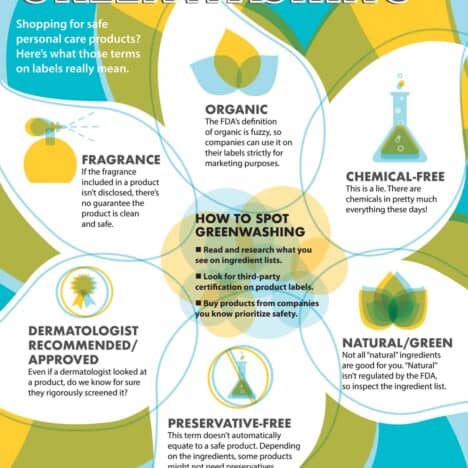
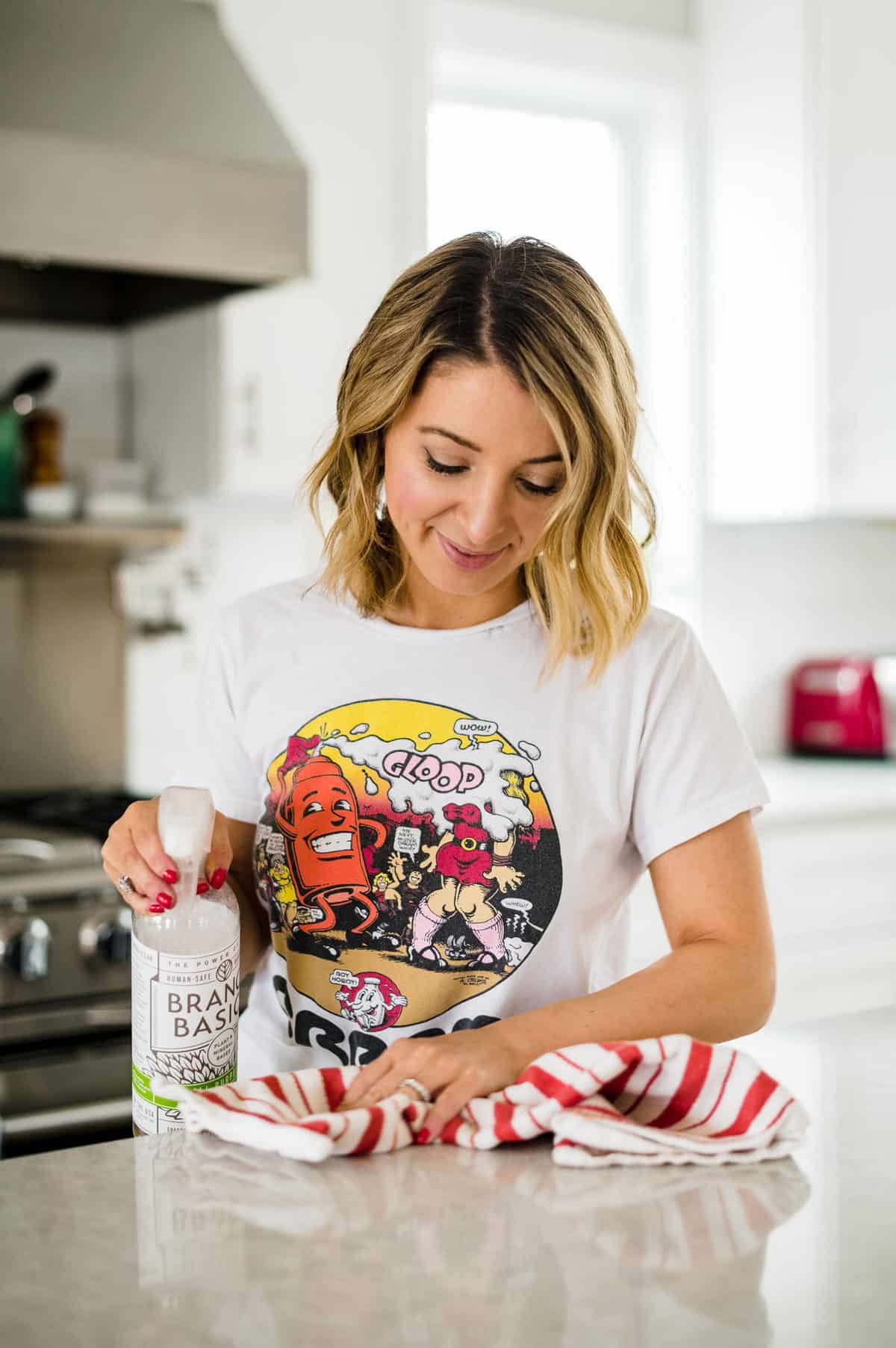
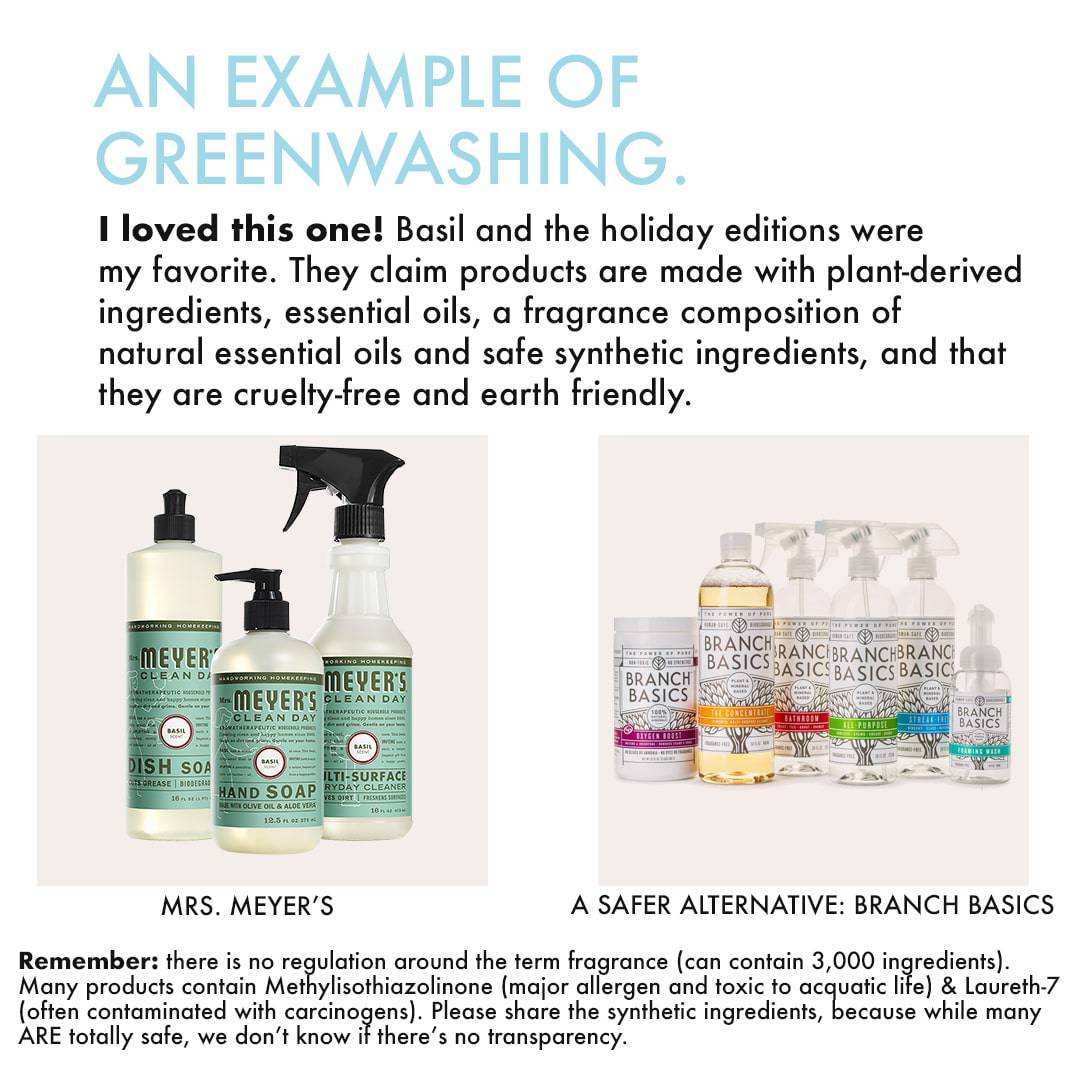
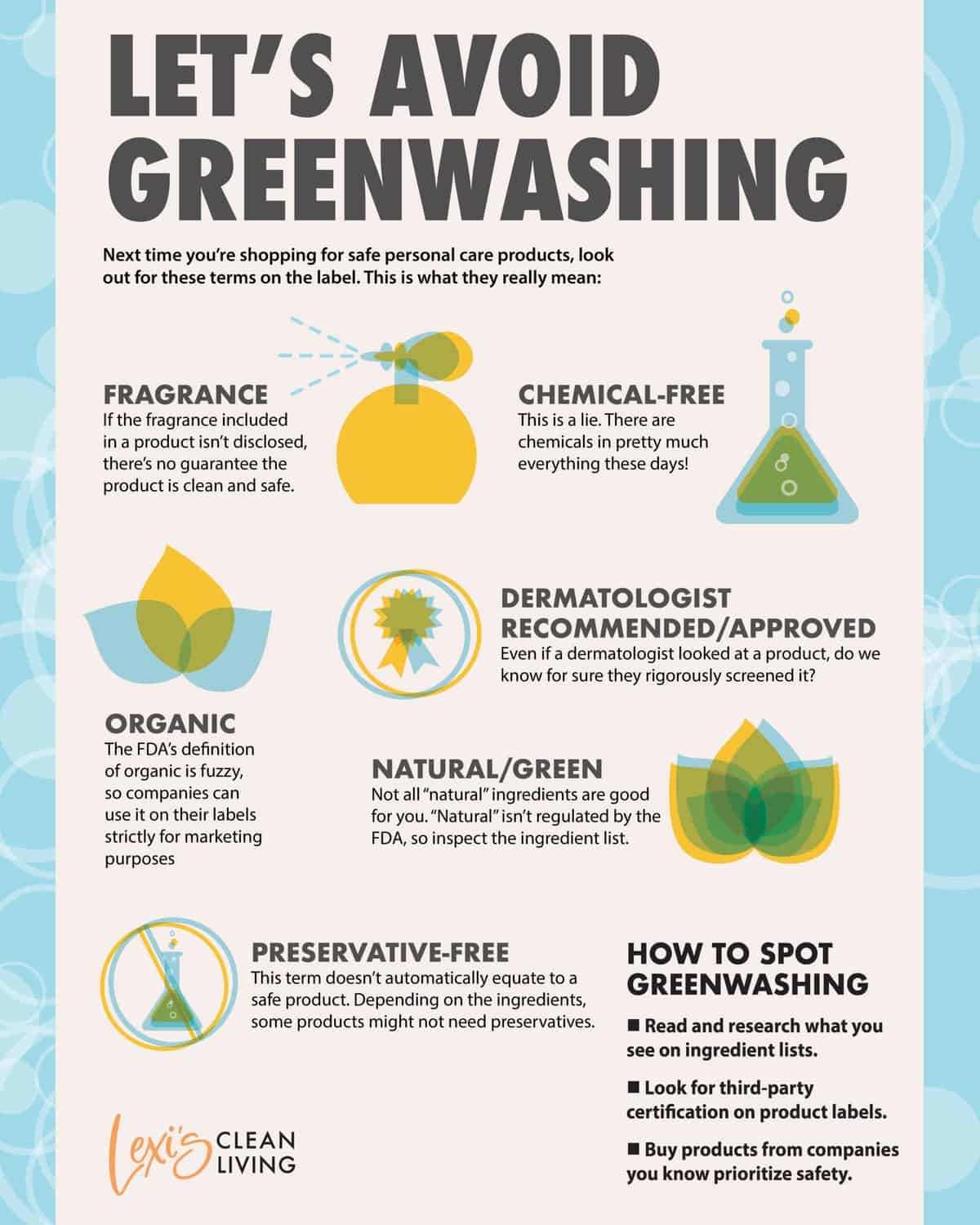





You left out Poofy Organics-they should be #1 on your list for safe products
I’ll check them out – haven’t tried them so can’t add to my list until I personally have! 🙂